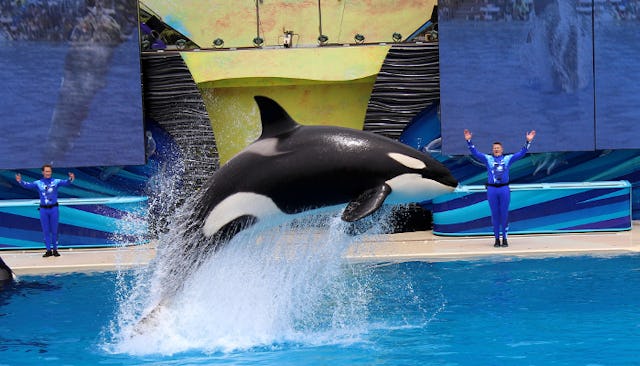SeaWorld Is Finally Putting An End To Killer Whale Shows, Breeding

SeaWorld says the current generation of orcas in captivity will be the last
SeaWorld announced today that they’ll no longer breed killer whales and that the current generation of orcas living in their parks will be the last. They’ll also be phasing out their theatrical orca shows starting next year. This is fantastic news for conservationists and animal rights activists, as well as consumers who’d abandoned the chain of parks in recent years over concern for the plight of the whales.
SeaWorld announced the move on their Facebook page with a video explaining their plan going forward.
In an op-ed for the Los-Angeles Times, SeaWorld president and CEO Joel Manby announced the plan to stop breeding orcas and explained the reasoning behind the long-awaited move. Citing a change in Americans’ attitudes about the marine creatures, he says that when the parks first opened in 1964, people were afraid of orcas and even hated them. Now that awareness about these animals is so widespread and the public has come to love them, having them in captivity and performing is no longer necessary for fostering that acceptance.
“This year we will end all orca breeding programs,” writes Manby. “Because SeaWorld hasn’t collected an orca from the wild in almost four decades, this will be the last generation of orcas in SeaWorld’s care. We are also phasing out our theatrical orca whale shows.”
Manby explains that simply “releasing” the whales like much of the public is asking is just not that simple: “Most of our orcas were born at SeaWorld, and those that were born in the wild have been in our parks for the majority of their lives. If we release them into the ocean, they will likely die. In fact, no orca or dolphin born under human care has ever survived release into the wild.”
Manby acknowledges the plight that many endangered species now face referring to the crisis as “the 6th extinction” with wild animals and wild places continuing to disappear. He says some scientists predict that “within a century, 50% of large mammals will be extinct.” He cites the “real” enemies of wild animals, including “poaching, pollution, unsustainable human development and man-made disasters such as oil spills.” Zoos and aquariums, he says, are not the biggest enemies to these animals.
And he’s correct. But that doesn’t mean it’s acceptable to continue breeding them in captivity and forcing them to perform, which is why these changes are such welcome ones. Amid drastically decreasing attendance numbers in the wake of the explosive 2013 documentary “Blackfish,” SeaWorld had to respond to the outcry from the public or face even more dire consequences. They’re absolutely doing the right thing.
As far as what life will be like for the whales who will continue to live at the parks? Manby insists they’ll receive the highest quality care and addresses concerns for the animals’ habitat in a Facebook post. When one commenter asked of the previously announced plans to improve and enlarge the whales’ habitat SeaWorld answered that they’re going to update the current living environment and make it more “natural.”
This natural approach includes phasing out the theatrical orca shows park attendees are able to see in favor of orca “encounters” that don’t involve the whales being forced to perform tricks for the audience. Starting next year, the shows will stop in San Diego. The other parks will stop in 2019.
It sounds like SeaWorld is taking all the right steps considering what they’re up against. They can’t release the whales currently in captivity out of concern for their very lives, but they can make sure no more whales will be born into a life spent inside a glass bowl with people watching their every move.
I went on a trip to SeaWorld a few years ago with the intent of writing about the park for a website. I was treated to a “behind the scenes” tour and met several of the trainers and staff. After my visit, I didn’t feel comfortable promoting the idea of the whales in captivity but during that trip, I was struck by what I saw — in more ways than one.
While it was jarring to see in person how very small their world was — that these whales were essentially living in a bath tub and probably weren’t as happy as the park wanted you to think they were, it was comforting to see how much the staff and trainers truly cared about them. Their love for these animals was clear and by the end of that tour, their desire to do right by them was something I didn’t question.
That’s why even though it’s not feasible to release them into the wild, we can all rest assured that those caring for them the rest of their lives have their best interests at heart. In an ideal world, they’d be swimming free in the ocean but since that can’t happen, professionals caring for them who deeply believe in what they do is the next best scenario. Kudos to SeaWorld for finally doing the right thing by these amazing animals.
This article was originally published on